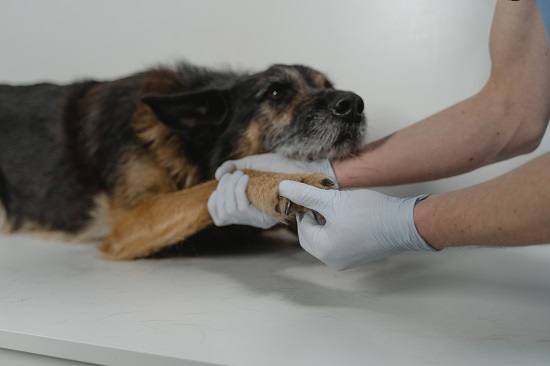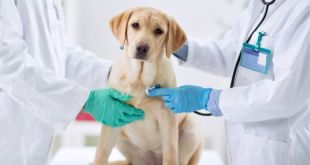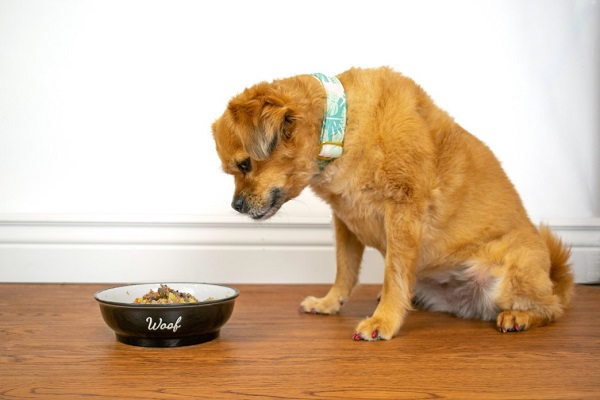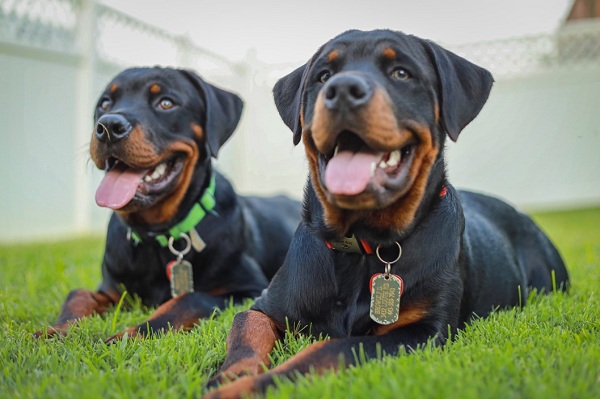Accidents can happen during walking, training, or even just moving around the apartment, leaving the dog powerless and causing physical harm. The owner should definitely know how to help the injured animal in this situation. Expert writers from the paper writing service provide a list of injuries and first aid instructions.
Dog injuries and first aid instructions
#1 Thorn
This can often be caused by plant thorns, awns of spikelets of wild oats, or wooden or metal objects. Once in the skin, the thorn causes inflammation, soreness, and limpness. Try to remove it with sterile tweezers. If this does not work right away and the thorn does not get too deep, warm baths can help, which will make the thorn and gleet come out. After a few baths, the thorn can be removed with tweezers. But if the thorn is too deep and the baths do not help, you should visit a vet doctor.
#2 Snake Bite
When hunting, dogs are sometimes bitten by vipers. If not treated immediately, it will die within 24 hours. In very rare cases, the dog itself recovers, although it partially or completely loses its sense of smell.
The symptoms are very characteristic: the dog stops, lies on the ground, howls, and cannot move normally. After a while, trembling, diarrhea, and vomiting appear. The bite site can be recognized by swelling, touching it is painful.
The first thing to do is to inject the dog subcutaneously with a specific anti-snake serum, the injection place does not matter. The serum can also help hours after the bite. If no serum is available, a pressure dressing is applied above the bite to prevent the venom from spreading throughout the body with the blood. The bite site is treated with a disinfectant solution. The dog is given tea or coffee with alcohol added. After administering first aid, the dog should be taken to the nearest veterinarian.
#3 Bite of wasps or other insects
An attack on a dog by a swarm of bees is an exceptional phenomenon. Most often you have to deal with wasp stings.
If a wasp stings a dog while playing or eating on the lip, then along with sharp pain, local inflammation occurs. But, as a rule, it is not dangerous. The bite site is blotted several times with cotton wool and moistened with a solution of vinegar or citric acid. If the dog shows increased sensitivity, it is better to apply a cold compress and drink warm strong sweet tea. In case of a bite in the mouth or nasopharynx, you should immediately contact your veterinarian. This is dangerous. The dog may suffocate as a result of swelling of the nasopharynx.
If you find swelling on the face, you need to find out the cause, it is not always the result of an insect bite.
#4 Swallowing a foreign object
Dogs, like children, can swallow anything: a pin, a hairpin, a sharp bone, a button, or pebbles they play with. These objects are not digested and can cause a perforation or blockage of the digestive tract, usually the stomach or intestines.
Some of the objects pass the dog’s body safely, while others get stuck in the esophagus, stomach, or intestines. If the object is lodged in the esophagus, it will take some time for anxiety, salivation, vomiting, and coughing to occur.
Try to open the dog’s mouth with a spoon, tweezers, or two fingers to remove the object. If this fails, be sure to see a specialist who has the right tools for this.
He will be able to remove the object or schedule an X-ray for immediate surgery. If there is no way to see a doctor, but the dog on a light diet and give one or two spoonfuls of liquid Vaseline oil. Never use laxatives or vomiting agents, they can only complicate the situation.
If your dog chokes on a sharp fish bone and it gets stuck in his throat, try to remove it as soon as possible.
#5 Burns
Depending on the factor that caused the burn, the extent of the burn, the area affected, and the circumstances of the accident, different treatment is prescribed. If it is a chemical burn, the burned surface must be washed with water or a neutralizing solution (a soda solution for acid burns, vinegar for quicklime burns).
Potassium permanganate and oil (olive oil, for example) are used for thermal burns. In any case, you should give painkillers and then see a veterinarian.
#6 Injury from electric current
Most often occurs when wires are bitten. It is accompanied by convulsive twitching of the muscles, disturbance of the rhythm of breathing, and pulse. Do not forget that the very first thing is to stop the current on the dog, and this should not be done with bare hands.
If the dog is unconscious, you should give him a sniff of ammonia, and after it regains consciousness, give it two teaspoons of wine with strong tea or coffee; if the shock is too deep and the dog has stopped breathing, then carry out artificial respiration: slowly squeeze the sides of the dog, then release the pressure, continue until independent breathing is restored. The dog should be calmed at all times, given pain medication, and seen by a specialist.
#7 Wounds
Tissue damages can be of various forms and severity, and the causes are numerous. They can occur as a result of a fight (bitten), during guard duty (stabbed, chopped), while hunting (gunshot), during an attack (bruised), etc.
Cut the hair around the wound, wash the wound with a hydrogen peroxide solution, treat the edges with iodine and bandage it. If the wound is small, a bactericidal plaster is enough. In other cases, first, a sterile napkin is applied, then absorbent cotton and a bandage on top.
A mild antiseptic can also be used, and a sprinkling of sulfonamide preparations will speed up healing. For ordinary wounds, daily treatment is sufficient. A special aerosol sold at the drugstore helps a lot, and it is a good idea to apply sea buckthorn oil to a wound that is healing.
#8 Tail injury
It is very common to injure the tail. If it has been pinched by a door and on examination the vertebrae are intact and only the skin is damaged, the wound should be treated and the dog should be given painkillers. In two or three days, the dog will start wagging its tail. If the tail is broken, a veterinarian should be consulted and a plaster cast applied.
#9 A gunshot wound
In this case, you cannot tell by the appearance of the wound how deep the shot has penetrated the tissue. It is absolutely necessary to have an X-ray taken in an X-ray room.
The dog’s future depends on whether vital organs and major muscles are damaged. The question of whether surgery is necessary and what the outcome will be is definitely a matter for the specialist.
#10 Bleeding
Small bleedings often stop on their own. In case of heavy bleeding, a pressure dressing is applied above the wound site. It should not be left for more than half an hour and should be loosened periodically. The wound may be irrigated with a clotting agent. When bleeding on the body, a tight bandage is sufficient.
Internal bleeding-intestinal, stomach, or nasal-canal bleeding-can be relieved or stopped by injecting a blood stopper into the mouth. Still, if you are bleeding heavily, try to call a doctor as soon as possible.
#11 Fractures of limb bones
This injury can vary in shape and severity, the dog owner is unable to determine the exact nature of the fracture, so the best advice is to take the dog to the vet as soon as possible. A dog with a fracture should be carried in your arms, holding it so that its limbs are free at the top.
Under no circumstances should you lower the dog to the ground to see if it can walk and lean on the injured limb. This usually dislocates the broken bones and further traumatizes the soft tissue. The best help is to place a splint on the injured limb and give pain medication.
#12 Urticaria fever
Most often urticaria fever affects short-haired dogs, especially hunting dogs. In addition to nettles, and other plants, bites of insects, and their larvae (caterpillars) can cause similar phenomena. Skin rashes are not particularly dangerous, but lesions of the mouth and throat are more serious.
The dog is disturbed by the burning sensation on the affected areas, it continuously licks and bites them, so that the burning hairs or poisonous secretions get on the tongue, gums, and mucous membrane of the oral cavity. From this point on, the situation becomes very dangerous.
In a nervous fit, the dog spins, rolls around on the ground, spits profusely, and sneezes. Then convulsions set in and, if not treated immediately, the dog will die of asphyxiation within a few hours.
So how do you treat a dog with urticaria fever? First, bathe him in cool water with vinegar essence added. If there has been obvious absorption, give the dog vomit or a mild laxative. Second, if the dog is very agitated, give him a sedative. Third, support heart activity with black coffee or an injection of caffeine.
#13 Constipation
Refrain from giving human laxatives under any circumstances. It is best to give your dog vegetable or Vaseline oil (1 tsp for small breeds). You can either use an enema or glycerine suppositories (they are usually made for children).
For chronic constipation look at the dog’s diet and nutrition; add about a coffee spoonful of Vaseline oil to his food. Contacting your veterinarian is a must.
Urinary retention. This is a “disease” of softies living in city apartments, sleeping on warm pillows, and not wanting to go for a walk in the rain or in the cold.
To put an end to these fancies, give your dog ten drops of sodium bicarbonate of soda three times at half-hour intervals. Rarely will a dog not pick up a paw in the street after this treatment!
If the dog won’t urinate despite trying or moaning, then the case is serious and requires the intervention of a veterinarian, as the cause may be serious illnesses such as cystitis, bladder stones, inflammation, or injury.
 DogExpress
DogExpress




















 in Chandigarh, India.
in Chandigarh, India. 

